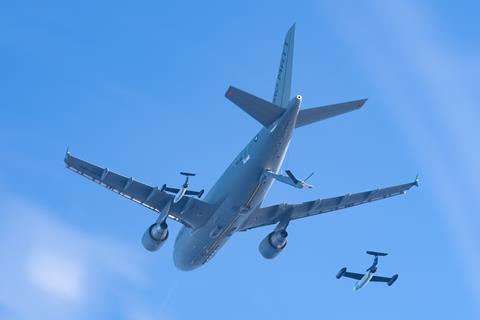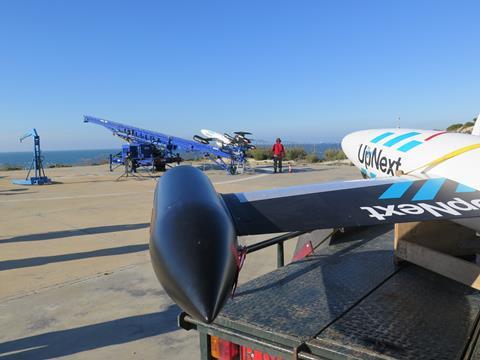Airbus has moved closer to commercialising a fully automated in-flight refuelling system following a series of successful test flights in southern Spain that saw a swarm of modified target drones flying in close formation, with their positions controlled by a tanker aircraft.
The 21 November trials, conducted by innovation arm Airbus UpNext, were the latest step in validating the technology – dubbed A4R – following an initial evaluation phase in March. Service entry could come by the end of the decade.

Part of a project called Auto’Mate, the evaluation used five DT-25 target drones – two of which were virtual – to conduct a simulated refuelling operation with an A310 Multi-Role Tanker Transport testbed operated by Airbus Defence & Space.
Starting with a single DT-25, plus two virtual unmanned aircraft, the test team progressively increased the number of drones in the air until all five were flying in formation.
Having been catapult launched from the CEDEA experimental flight-test centre in El Arenosillo, near Huelva in southern Spain, the DT-25s were flown by operators on the ground towards the A310, which was on station at around 5,000ft following departure around 1h earlier from Airbus’s Getafe base near Madrid.
Once in range – between 300-500m (980-1,640ft) away – a test engineer aboard the tanker was able to transfer control of the drones to the MRTT.
These, plus the two virtual drones, could then be automatically manoeuvred in formation as if receiving fuel. They approached from the port side of the aircraft, manoeuvred astern, transitioned to a pre-contact position, and then exited to the right.
While at their closest the receiver aircraft remained 25m astern of the A310, by using a virtual “ghost tanker” UpNext was able to “reproduce the whole air to air refuelling process”, says the company’s Isaac Perez Fafion.
Rather than having the drones close to a potentially dangerous distance of the MRTT, they were instead flown to a pre-contact position with the virtual aircraft, which was ‘positioned’ to the rear of the real tanker.

UpNext had in March performed a previous Auto’Mate flight test during which it assessed the performance of sensors installed on the MRTT – including LIDAR, cameras and differential GPS – and the flight-control software in preparation for the latest sorties.
Gonzalo Martin Gomez, head of the Auto’Mate, says the project’s goal was to examine which technologies are needed to achieve the highest levels of automation, plus gain a better understanding of the operational requirements.
Using the March effort as a foundation, the latest test was focussed on “three main pillars”, he says: communications and data links, accurate relative positioning through sensor fusion, and AI-based co-operative control algorithms. “We are more than happy with the results,” he adds.
Data from the testing will now be transferred to Airbus Defence & Space “so they are in a position to continue this to a product for our customers”, says Fafion.
“UpNext’s role is about developing the technology to make this real, about testing that it works in an operational environment and demonstrating that it is feasible.
“Then bringing it to a certifiable product – that’s where we hand it over to the team at Defence & Space.”
Having already brought into service its A3R system for the A330 MRTT – automating the contact between the refuelling boom and receiver aircraft – Airbus’s defence unit sees increased automation of the wider process as key to maintaining “the leadership that we have in the market”, says Maria Angeles Marti, its head of the MRTT programme.

“The only way to remain there is by being pioneers in technology; we want to be pioneers in automatic air-to-air refuelling.”
That capability will increase safety and operational efficiency for customers, she argues.
While such a system could be on the market by the end of the decade, it is also seen as a vital building block for the Future Combat Air System programme being developed by France, Germany and Spain, which foresees the extensive use of unmanned remote carrier aircraft capable of being refuelled in flight.
But before targeting higher levels of overall automation on the MRTT, “as a next step” Airbus Defence & Space will first look to add its A3R technology to the aircraft’s hose and drogue system by around 2025, says Marti. That effort will also be aided through work funded by the European Defence Agency; flight tests under that project are scheduled for 2024.
To date, only Singapore has signed for the A3R system on its MRTT fleet and has qualified its use with the Lockheed Martin F-16 and the tanker itself.
Approval for use with the Boeing F-15 is expected in the first half of next year, adds Marti, with the Lockheed F-35 and potentially other receptacle-equipped platforms also in the development roadmap.



























